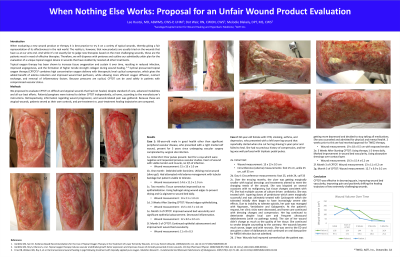Case Series/Study
(CS-153) When Nothing Else Works: Proposal for an Unfair Wound Product Evaluation

When evaluating a new wound product or therapy it is best practice to try it on a variety of typical wounds, thereby giving a fair representation of its effectiveness in the real world. The reality is, however, that new products are usually tried on the wounds that have us at our wits end. And while it’s not exactly fair to judge new therapies based on the most challenging wounds, these are the patients most in need of effective therapies. Therefore, we will dispense with pretense and outline our admittedly unfair plan for the evaluation of a unique topical oxygen device in wounds that have stubbornly resisted all other treatments.
Methods:
In recent months and ongoing, we have evaluated CPTOT on difficult and atypical wounds that have not healed, despite standard of care, advanced modalities and all our best efforts. Patients/caregivers are trained to deliver the therapy independently, at home, according to the manufacturer’s instructions. Information regarding wound progression, wound-related pain and treatment compliance is and will continue to be gathered. Because these are atypical wounds, patients will serve as their own controls, and pre-treatment vs. post-treatment healing trajectories will be compared.
Results:
Findings / case examples will be reported with the idea that, even in an unfair evaluation, much can be learned.
Discussion: Topical oxygen therapy has been shown to increase tissue oxygenation and sustain it over time, resulting in reduced infection, improved angiogenesis, and the formation of higher tensile strength collagen during wound healing. 1–3 Cyclical pressurized topical oxygen therapy (CPTOT) combines high concentration oxygen delivery with therapeutic level cyclical compression, which gives the added benefit of edema reduction and improved wound bed perfusion, while allowing more efficient oxygen diffusion, nutrient exchange, and removal of inflammatory factors.
Trademarked Items: TWO2 AOTI, Inc., Oceanside, CA
References: 1. Gordillo GM, Sen CK. Evidence-Based Recommendations for the Use of Topical Oxygen Therapy in the Treatment of Lower Extremity Wounds. Int J Low Extrem Wounds. 2009;8(2):105-111. doi:10.1177/1534734609335149
2. Gordillo GM, Roy S, Khanna S, et al. Topical oxygen therapy induces vascular endothelial growth factor expression and improves closure of clinically presented chronic wounds. Clin Exp Pharmacol Physiol. 2008;35(8):957-964. doi:10.1111/j.1440-1681.2008.04934.x
3. Fries RB, Wallace WA, Roy S, et al. Dermal excisional wound healing in pigs following treatment with topically applied pure oxygen. Mutation Research - Fundamental and Molecular Mechanisms of Mutagenesis. 2005;579(1-2):172-181. doi:10.1016/J.MRFMMM.2005.02.023

.png)
